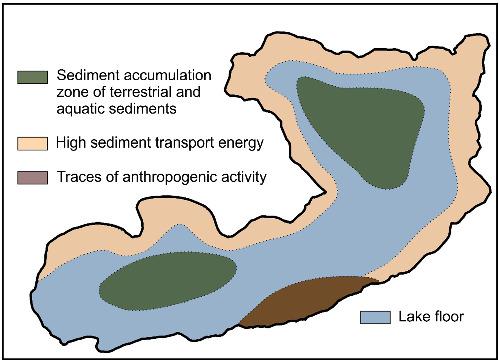当前位置:
X-MOL 学术
›
Earth Surf.Process. Land.
›
论文详情
Our official English website, www.x-mol.net, welcomes your
feedback! (Note: you will need to create a separate account there.)
The spatial distribution of sedimentary compounds and their environmental implications in surface sediments of Lake Khar Nuur (Mongolian Altai)
Earth Surface Processes and Landforms ( IF 2.8 ) Pub Date : 2020-12-14 , DOI: 10.1002/esp.5049 P. Strobel 1 , J. Struck 1 , R. Zech 1 , M. Bliedtner 1
Earth Surface Processes and Landforms ( IF 2.8 ) Pub Date : 2020-12-14 , DOI: 10.1002/esp.5049 P. Strobel 1 , J. Struck 1 , R. Zech 1 , M. Bliedtner 1
Affiliation

|
Lake sediments are valuable natural archives to reconstruct paleoclimate and paleoenvironmental changes which consist of inorganic and organic sediment compounds of allochthonous origin from the catchment and of autochthonous production in the lake. However, for robust paleo‐reconstructions it is important to develop a better understanding about sedimentation processes, the origin of inorganic and organic sediment compounds and their distribution within the lake. In this context, modern process studies provide important insights, although environmental and anthropological changes can affect the spatial distribution of sediment compounds through time. Therefore, in this study the spatial distribution of grain size and geochemical proxies in 52 surface sediment samples from Lake Khar Nuur, a small high‐altitude lake in the Mongolian Altai with a small and anthropogenically used hydrological catchment, is investigated. The results show a distinct sediment focussing in the two deep basins of the lake, which therefore act as accumulation zones. In those accumulation zones, total organic carbon (TOC), total nitrogen (N) and their isotopic composition (δ13CTOC, δ15N) as well as n‐alkanes indicate that organic sediment compounds are a mixture of both allochthonous and autochthonous origin. While the recent catchment vegetation consists of grasses/herbs and the shrub Betula nana (L.) with distinct differences in their n‐alkane homologue patterns, those differences are not reflected in the sediment surface samples which rather indicates that grass‐derived n‐alkanes become preferentially incorporated in the lake. Extensive anthropogenic activity such as grazing and housing in the southern part of the catchment causes soil erosion which is well reflected by high TOC, N and sulphur (S) contents and 15N depleted δ15N values at the central southern shore, i.e. increased allochthonous sediment input by anthropogenically‐induced soil erosion. Overall, the surface sediments of Lake Khar Nuur origin from allochthonous and autochthonous sources and are focussed in the accumulation zones of the lake, while their distribution is both environmentally and anthropogenically driven.
中文翻译:

喀尔努尔湖(蒙古阿尔泰)表层沉积物中沉积物的空间分布及其对环境的影响
湖泊沉积物是有价值的自然档案,可重建古气候和古环境的变化,该变化由湖泊中流域和本地生产的异源无机和有机沉积物组成。但是,对于健壮的古构造,重要的是要更好地了解沉积过程,无机和有机沉积物的来源以及它们在湖中的分布。在这种情况下,尽管环境和人类学的变化会随着时间的推移影响沉积物化合物的空间分布,但现代过程研究仍提供了重要的见识。因此,在这项研究中,来自喀尔湖的52个地表沉积物样品的粒度和地球化学替代物的空间分布,研究了蒙古阿尔泰的一个小型高海拔湖泊,其中有一个小型的人为使用的水文集水区。结果表明,在湖的两个深盆中有明显的沉积物集中,因此它们是积聚区。在这些堆积区中,总有机碳(TOC),总氮(N)及其同位素组成(δ13 Ç TOC,δ 15 N)以及ñ -烷烃表明有机沉积物化合物均为外来和原地来源的混合物。虽然最近的集水区植被由草/草本和灌木桦木(L. Betula nana)组成,但它们的正烷烃同系物模式存在明显差异,但这些差异并未反映在沉积物表面样本中,而是表明草源正烷烃优先纳入湖中。集水区南部广泛的人为活动(例如放牧和居住)引起土壤侵蚀,这主要体现在高TOC,N和硫(S)含量以及15Ñ耗尽δ 15 N个值在中央南部的岸,即由人类活动引起的土壤侵蚀增加异地沉淀输入。总体而言,喀尔努尔湖的表层沉积物来源于异源和本地,主要集中在湖泊的聚集区,而其分布既受环境影响,也受人为驱动。
更新日期:2020-12-14
中文翻译:

喀尔努尔湖(蒙古阿尔泰)表层沉积物中沉积物的空间分布及其对环境的影响
湖泊沉积物是有价值的自然档案,可重建古气候和古环境的变化,该变化由湖泊中流域和本地生产的异源无机和有机沉积物组成。但是,对于健壮的古构造,重要的是要更好地了解沉积过程,无机和有机沉积物的来源以及它们在湖中的分布。在这种情况下,尽管环境和人类学的变化会随着时间的推移影响沉积物化合物的空间分布,但现代过程研究仍提供了重要的见识。因此,在这项研究中,来自喀尔湖的52个地表沉积物样品的粒度和地球化学替代物的空间分布,研究了蒙古阿尔泰的一个小型高海拔湖泊,其中有一个小型的人为使用的水文集水区。结果表明,在湖的两个深盆中有明显的沉积物集中,因此它们是积聚区。在这些堆积区中,总有机碳(TOC),总氮(N)及其同位素组成(δ13 Ç TOC,δ 15 N)以及ñ -烷烃表明有机沉积物化合物均为外来和原地来源的混合物。虽然最近的集水区植被由草/草本和灌木桦木(L. Betula nana)组成,但它们的正烷烃同系物模式存在明显差异,但这些差异并未反映在沉积物表面样本中,而是表明草源正烷烃优先纳入湖中。集水区南部广泛的人为活动(例如放牧和居住)引起土壤侵蚀,这主要体现在高TOC,N和硫(S)含量以及15Ñ耗尽δ 15 N个值在中央南部的岸,即由人类活动引起的土壤侵蚀增加异地沉淀输入。总体而言,喀尔努尔湖的表层沉积物来源于异源和本地,主要集中在湖泊的聚集区,而其分布既受环境影响,也受人为驱动。











































 京公网安备 11010802027423号
京公网安备 11010802027423号